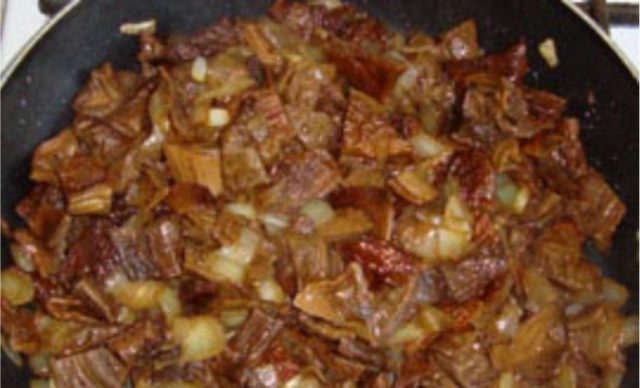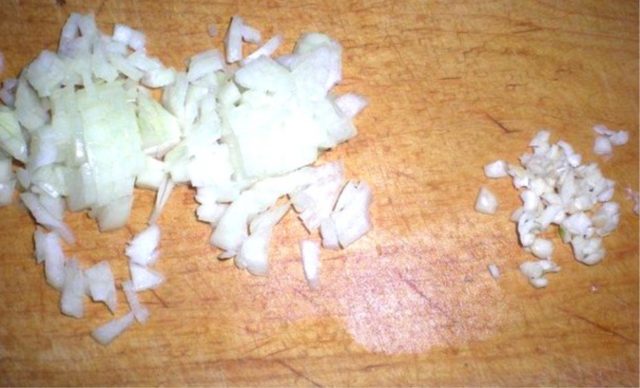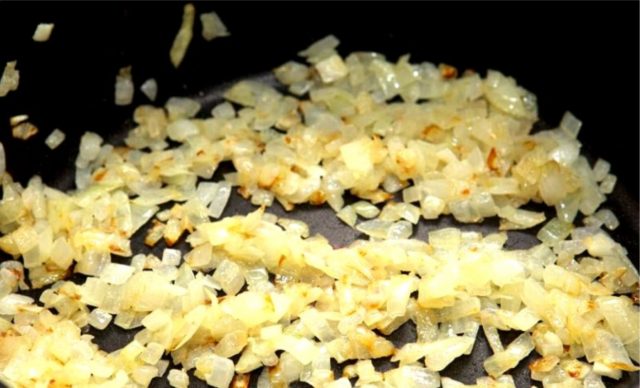Contents
Whites or white waves are one of the most common types of mushrooms, but very few people recognize them and even more so put them in their basket. But in vain, because in terms of composition and nutritional value, these mushrooms belong to the second category. They can be compared with milk mushrooms and mushrooms. Cooking porcini is just as easy as russula, rows and other agaric mushrooms. You just need to be aware of some of the features of their preparation, without observing which, you can be disappointed in these delicious gifts of the forest from the very beginning.
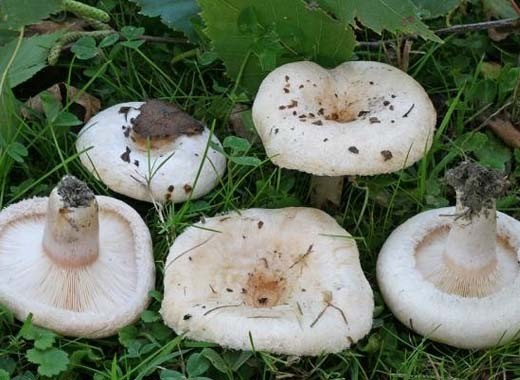
How to cook whites
The name of volushek mushrooms is more well-known than whites. Meanwhile, whites are just the same waves with hats of white and milky colors. Just like ordinary volushki, they have patterns in the form of concentric circles on their hats. Under the hat, you can also find a kind of fluffy fringe, which serves as a hallmark of all waves from other similar mushrooms. White volnushki differ only in slightly smaller caps, in diameter they rarely exceed 5-6 cm. Often there are young mushrooms with a cap diameter of about 3-4 cm.
When cutting whites, white milky juice is released from them, which is very bitter, although the aroma from them comes from a pleasant, filled with freshness. It is because of the bitter taste that these mushrooms are conditionally edible. Although this only means that they cannot be consumed fresh. It is possible to cook various dishes from them only after special processing, when whites turn into mushrooms that are very tasty and healthy in composition.
Like other waves, whites are used mainly for salting and pickling. Due to their strength, they make wonderful preparations for the winter: crispy, spicy and fragrant. But this does not mean at all that the white wave is not suitable for preparing everyday dishes.
How to properly prepare the whites so that they do not taste bitter
It is important to start processing whitefish as soon as possible after they are brought from the forest so that they do not start to deteriorate.
After the usual sorting and washing procedure, traditional for any mushrooms, they begin to clean the white waves. Here it is important not so much to remove rubbish from the surface of the hats and renew the cut of the stem, but to clean the hat from the fringe covering it. It is in it that the maximum amount of bitterness contained in whites is contained.
In addition, it is advisable to cut each hat into two parts to make sure there are no worms. This can be especially relevant in dry and hot weather.
After all these traditional procedures, before you start directly preparing white waves, they must be soaked in cold water. So that the milky juice goes away, and with it all the bitterness, and other possibly unpleasant properties of white mushrooms.
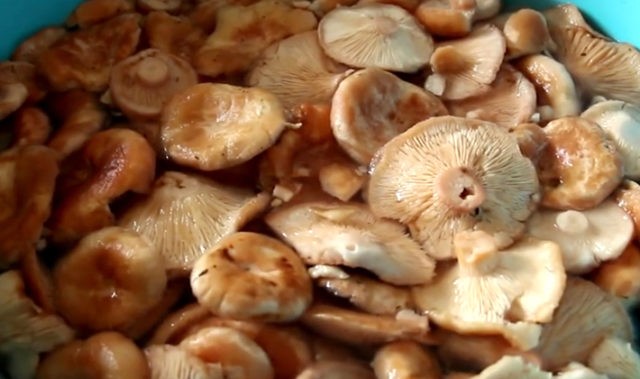
Soak white waves, if desired, up to 3 days, be sure to replace the water with fresh water every 10-12 hours.
How and how much to cook whites before cooking
To finally prepare the whites for use in any culinary recipes, they must be additionally boiled. Depending on the further methods of preparing mushrooms, whites are boiled:
- twice in salt water, each time for 20 minutes, be sure to pour out the intermediate broth;
- once for 30-40 minutes with the addition of 1 tsp. salt and ¼ tsp. citric acid per liter of broth.
The first method is used most often for the preparation of caviar, salads, meatballs, dumplings.
The second method is used for soups and subsequent frying, baking or stewing.
In principle, preparing whitefish for cooking is not so difficult, and the description and photo of recipes will help even novice hostesses create real masterpieces from this mushroom.
Is it possible to cook soup from a white wave
Soups from white waves are very tasty and healthy. Moreover, you can make them not only from soaked and boiled mushrooms, but also use salted whites for this.
Is it possible to fry whites
There are many different recipes by which you can cook fried whites. Opinions about the taste of dishes sometimes differ, but if we are talking about white waves, then a lot depends on the correct preliminary preparation, and on the spices and spices used.
How to fry whites with onions
One of the easiest recipes for fried whites. The process will not take more than 15 minutes, not counting the preliminary preparation procedure.
You need:
- 1000 g of boiled white waves;
- 2 bulbs;
- salt and ground black pepper – to taste;
- vegetable oil for frying.
Preparation:
- Peeled onions are cut into half rings and fried over medium heat for 5 minutes.
- White waves are cut into convenient-sized pieces, sent to the pan with onions, mixed and fried for another 5 minutes.

- Add salt, spices and keep on fire for the same amount of time.
As a side dish for fried whites, you can use rice, potatoes or stew.
How to fry white mushrooms with sour cream
Especially seductive are white waves fried with sour cream.
You need:
- 1500 g of boiled whites;
- 2 bulbs;
- 3 garlic cloves;
- 1,5 glasses of sour cream;
- 1 carrot;
- 3 st. l. butter;
- salt and pepper to taste;
- 50 g chopped parsley.
Cooking white mushrooms with sour cream will become even easier if you focus not only on the verbal description, but also on the photo of this process.
Preparation:
- Garlic and onion are peeled, chopped with a sharp knife and fried in butter until golden brown.

- Boiled whites are dried, cut into cubes and placed in a pan with spicy vegetables, frying everything together for another 10 minutes.

- Peeled carrots are rubbed on a medium grater and added to fried mushrooms. Also at this moment salt and pepper the dish.
- Pour in sour cream, mix and simmer over low heat for another quarter of an hour.

- A few minutes before readiness, chopped parsley is added to the mushrooms.
How to fry whites in batter
Among the recipes for cooking fried whites, battered mushrooms are one of the most original dishes that are suitable, including for the festive table.
You need:
- 1 kg of white waves;
- 6 art. l. flour of the highest grade;
- 3 garlic cloves;
- 2 chicken eggs;
- chopped dill;
- vegetable oil for roasting;
- 1/3 tsp ground black pepper;
- to taste the salt.
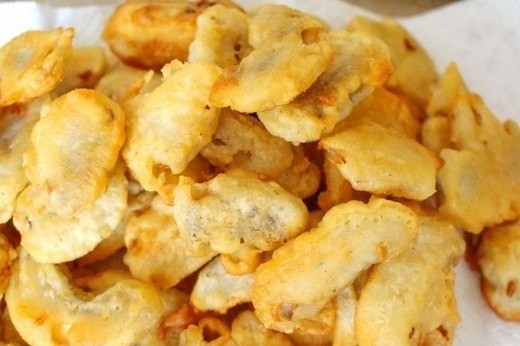
Preparation:
- The legs are cut off from the whites, leaving only the hats, salted, set aside for a while.
- 3 art. l. flour is mixed with eggs, chopped herbs and garlic, ground black pepper and lightly beaten.
- Pour such an amount of oil into the pan so that the mushroom caps can swim in it, heat it to a hot state.
- Roll white volnushki in flour, then dip in cooked batter (egg mixture) and roll again in flour.
- Spread in a pan and fry until a crispy light brown crust forms.
- Alternately spread the fried whites on a paper towel, allowing the excess fat to soak a little.
How to cook soup from white waves
White mushroom soup can be cooked on both vegetable and chicken broth. In any case, the first dish will pleasantly diversify the usual assortment.
You need:
- 0,5 kg of boiled whites;
- 5-6 potato;
- 1 onion and carrot each;
- 2 liters of broth;
- 2 tbsp. l. chopped dill or parsley;
- vegetable oil for frying and salt to taste.
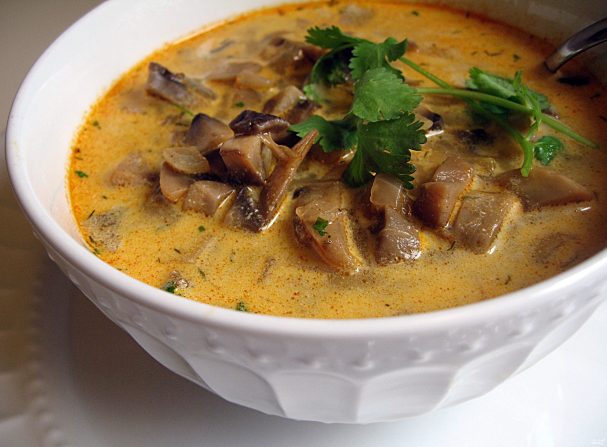
Preparation:
- White waves are cut into pieces and fried in oil until golden brown.
- Vegetables are washed, peeled and peeled off and cut: potatoes and carrots – into strips, and onions – into cubes.
- The broth is placed on the fire, potatoes are added to it and boiled for 10 minutes.
- Carrots with onions are added to the pan with mushrooms and fried for the same amount of time.
- Then the entire contents of the pan are combined with the broth and boiled for about a quarter of an hour.
- Add salt and spices, sprinkle with herbs, mix well and, turning off the heat, leave to infuse for at least 10 minutes.
How to cook white mushrooms stewed in white wine
Cooking white mushroom in white wine is not difficult, but the result will be so impressive that this recipe will be remembered for a long time.
You need:
- 700 g of boiled white waves;
- 3 st. l. butter;
- 2 Art. l. vegetable oils;
- 2 heads of white sweet onions;
- 150 ml of dry white wine;
- 250 ml of sour cream;
- a few sprigs of thyme;
- ½ tsp ground pepper mixtures;
- to taste the salt.
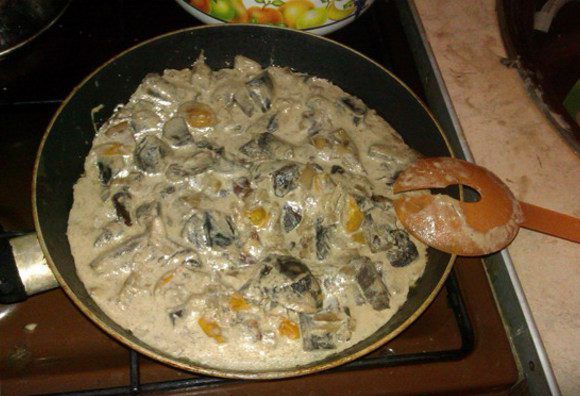
Preparation:
- Whites are cut into arbitrary slices.
- Onions after peeling are cut into half rings.
- In a frying pan, white onions are fried in vegetable oil.
- Butter is added, followed by mushrooms, finely chopped thyme and spices.
- All components are mixed and fried for 10 minutes.
- Pour in dry wine and simmer over medium heat for another 5-7 minutes.
- Sour cream is added, mixed thoroughly, covered with a lid and simmered over low heat for at least a quarter of an hour.
- They taste it, add salt if necessary and serve it on the table as an independent dish or side dish.
Recipe for white mushrooms baked in the oven
Among other ways to prepare white waves, one cannot fail to mention baking them in the oven. This recipe should definitely appeal to men and all lovers of spicy dishes, and cooking according to it is not at all difficult.
You need:
- 500 g of prepared whites;
- 500 g of pork;
- 3 bulbs;
- 4 garlic cloves;
- 1 pod of hot pepper;
- 1/3 h. l. coriander;
- 200 ml of sour cream;
- 50 ml of water in each pot;
- ground black pepper and salt to taste.

Preparation:
- The meat is washed under cold water, dried and cut into thick strips.
- Whites are cut into pieces of a similar shape and volume.
- Peeled onions are chopped in half rings.
- The pod of hot pepper is freed from seeds and cut into thin strips.
- The garlic is crushed with a sharp knife.
- In a large bowl, combine mushrooms, meat, hot peppers, onions and garlic, add salt and spices.
- Stir and infuse for a quarter of an hour.
- Then distribute the resulting mixture in pots, add 50 ml of water to each.
- Put sour cream on top, cover with a lid and place in an oven preheated to 180 ° C.
- Bake for 60 to 80 minutes depending on the size of the pots.
Conclusion
Cooking white fluffies is not at all difficult. If during the autumn season of mushroom picking stock up on whites for the winter, then you can treat your household with delicious and nutritious dishes from them all the long winter.










